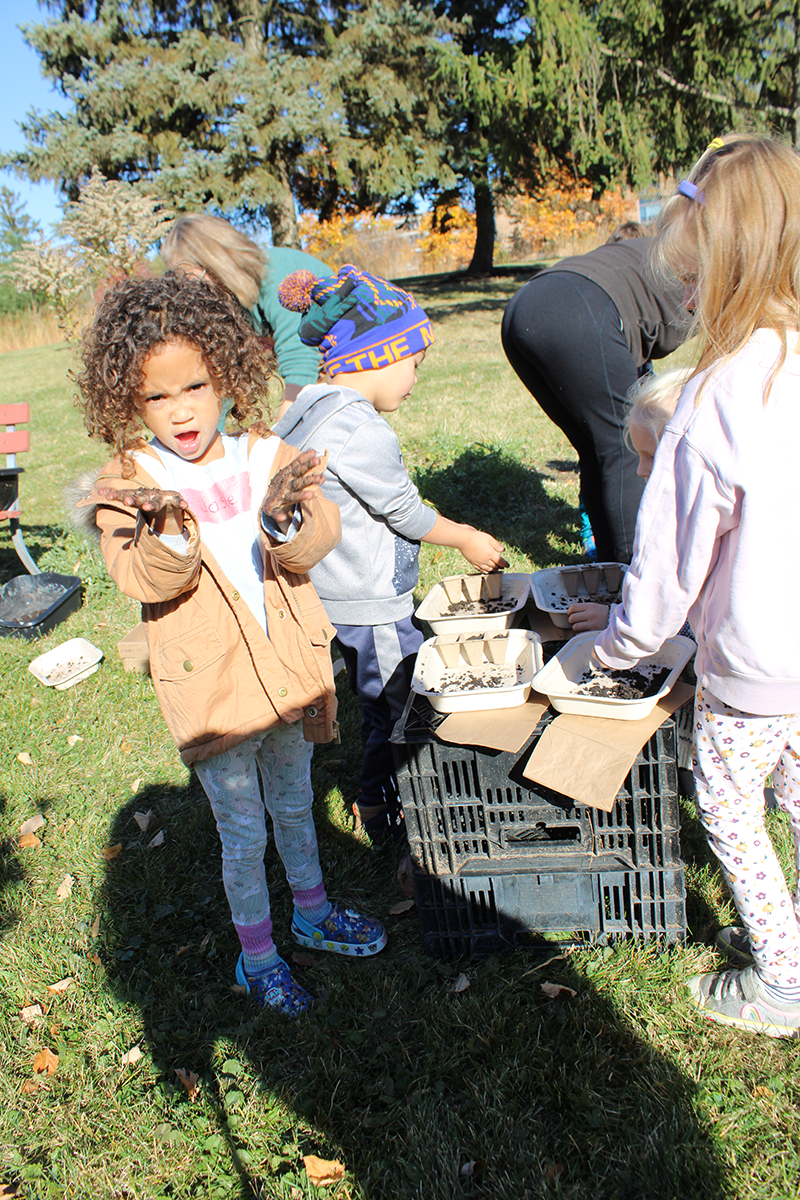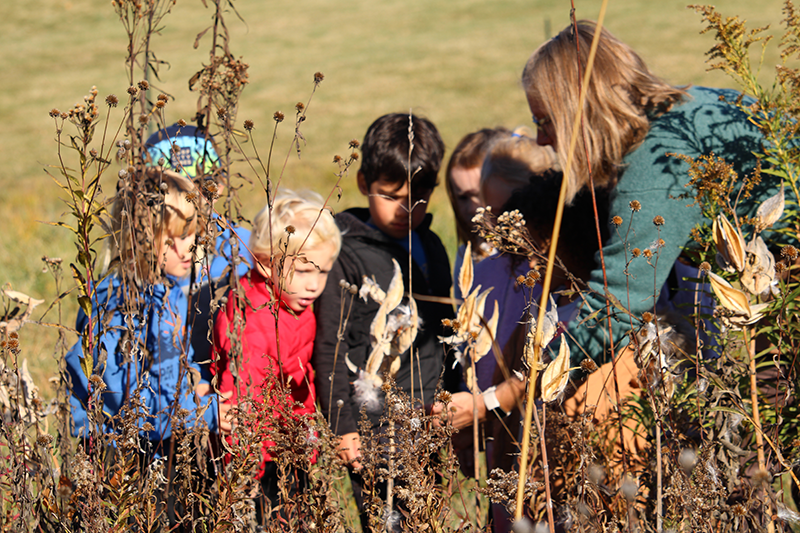
by Rebecca Marquardt, PLA, SITES AP

A grant from the Wildflower Association of Michigan (WAM) is helping fund a native wildflower and pond project at Marywood with Landscape Architect Rebecca Marquart and Dominican Sisters ~ Grand Rapids.
On Thursday, October 24, 18 young explorers, ages 4 and 5, visited the Marywood prairie of the Dominican Sisters ~ Grand Rapids with me and Christine Albertini and their classroom teachers.
We hiked on the mown trails through the prairie in the predominantly wildflower section. We saw the seedheads for all of the plants, many still very full of their seeds as birds have not completely eaten from the buffet. No doubt this rich and abundant seed source will continue to provide for the birds well into winter.
The opportunity to walk the paths for hiking with the Whistle Stop children was quite special. We told them they had permission to pick one of the Bee Balm seedheads to observe very closely.
We asked the kids, “Who do you see visiting flowers when you go for hikes around here?” “Butterflies!” “Honeybees!” “Caterpillars!” “Spiders!” “Ladybugs!” “Beetles!” We were impressed by their thorough understanding of this ecosystem!
These are the types of intentional place-based education experiences that the Dominican Sisters ~ Grand Rapids are supporting and nurturing at Marywood. It is tied to the Congregation’s Care of Creation and Laudato Si’ Commitments.

The Wildflower Association of Michigan allocated funds to this native wildflower and pond project. The Wildflower Association of Michigan’s (WAM) annual WAM Grant program funds projects that support the WAM mission. WAM has donated to non-profit groups all around Michigan.
WAM Grants have supported schools to establish native plant gardens, assisted non-profit organizations to purchase native plants for restoration projects, provided signage to educate the public about native plants, and much more. It is our desire to educate Michigan’s citizens to recognize, preserve, restore and re-create the native landscape and to pass on an appreciation and respect for our native flora.

Planting A Pollinator Garden
We explained that we would like their help to grow and build a new pollinator garden that will be full of wildflowers to invite all of those insects and bugs to visit and call home.
First we stopped by the pond, a place they regularly hike around and know well. We showed them the new sign that says, Future Native Garden, and explained they are going to help us start the process of growing the wildflowers today that will fill this garden!

We also showed them the new trees at the pond, but wanted the focus to be on the new garden so saved some of the stories for another time.
Onto the prairie. “What’s a prairie?” young Ben asked. Excellent question! It is full of taller grasses and many different kinds of wildflowers and usually does not have any trees.
“What’s a wildflower?” It is a plant that has pretty flowers and is found in nature. Many different kinds of wildflowers draw in and attract many different kinds of bees, butterflies and all the other insects all of you mentioned.
Once we got to the prairie, we invited them onto the mowed path to closely examine all the different kinds of seedheads of the wildflowers. Explaining that where we see dark brown round seedheads on the stalks were colorful wildflowers of yellows, pinks, purples, blue and white this summer. We had each of them pick a Bee Balm seedhead off the stalk.
Look closely at the little holes we see, now turn it upside down and shake it into your hand. What do you see sprinkling out that looks like pepper in your hand? Those are the Bee Balm’s seeds! Each of these seedheads all around us has their own seeds inside. Birds visit and collect these seeds to eat now and even into winter. Since there are so many plants, we also can take some seeds to grow and become plants we will use in your new garden by the pond.

Outdoor Classroom in the Prairie Habitat
We got messy getting our hands in the wet mixture of soil, compost, clay and water. It’s a little like playing with playdough, but a little muddier! We will wash hands, so don’t worry about getting them dirty – it’s part of the process to make these little marbles. We showed them some real marbles to get the idea of how small to make each one. The wildflower seeds get smooshed into the marble when we rolled it around in our hands, cover the seeds so they stay nice and protected. Rain will wash away the soil and clay over the winter and leave the seed to grow when the time is right in the spring.
Everyone made three marbles that we kept in a bag with their names to dry out. We wanted to make it a secret that not all those three are needed to make the garden. We want them to take some home to make their own wildflower gardens – that’s going to be the surprise!
Now they just need a couple of weeks to dry out and will get delivered back to Whistle Stop with some instructions and a note of gratitude for helping us grow the future garden!

Monarda Fistulosa / Bee Balm / Wild Bergamot
Bumblebees, non-native honeybees, many other native bees, butterflies, beetles, wasps, flies, spiders and other invertebrates visit the Monarda flowers to collect pollen and nectar or hunt for prey that visit collecting these floral rewards.

This is the dried seedhead of the Monarda. The children all were invited to harvest one and discover how the seeds are inside each of these hollow tubes that appear like holes. Some of the kids noticed there was a fragrance: “Mint!” One of the children declared. Another followed with “Chocolate!” I silently agreed, yet in all my years of not naming what I smelled, had not thought of that.

Our sense of smell is one of the most important channels to deep memory, and grateful for these special opportunities to access some of my earliest memories. That minty-chocolate-like smell reminded me of the gum my dad would find and bring home, by Hubba Bubba, in the early 80s.
In the outdoor classroom, I was grateful for the assistance of the teachers of Whistle Stop Child Care and Christine Albertini, Dominican Associate.









